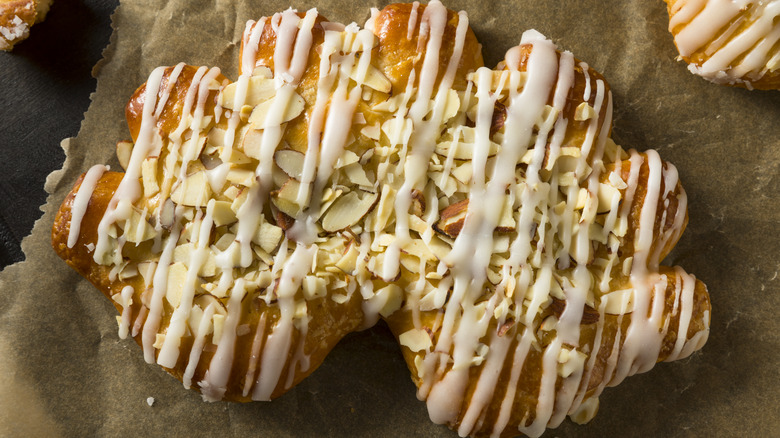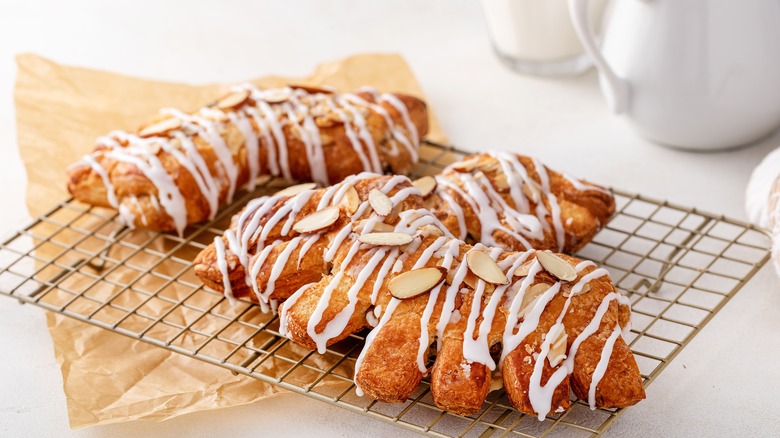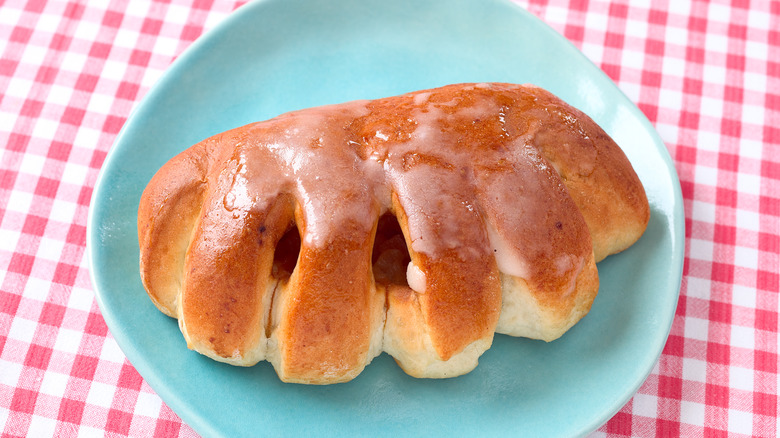What, Exactly, Is A Bear Claw?
In sports, they retire your number when you reach legendary status. In the bakery, there are certain items that stop being known by their ingredients and take over ownership of the entire shape. We all use donuts, pies, and hotdog buns to explain shapes in everyday life. We recognize if a croissant is particularly curved or not. So although you could call a pizza pocket that's been cut to appear to have splayed fingers a bear claw, you would have some explaining to do because everyone is expecting a bear claw to be a filled, flaky Danish pastry.
While there doesn't appear to be a specific date when they came about, bear claws were a thing by the 1910s, a time when Danish pastries were becoming more popular in America. President Woodrow Wilson had a famous Danish baker make pastries for his wedding in 1915. That same year, the term "bear claw" was used to refer to filled coffee cakes in an advertisement published in the Los Angeles Evening Express, and back in 1914, a California-based German bakery offered an item it called bear claws. For more than a hundred years, the term has come to mean a toothsome combination of flaky pastry with a rich, sweet, almost buttery almond filling that is perfect to accompany coffee.
How do they make bear claws?
The crucial ingredient in any Danish pastry is the pastry itself. Although using frozen puff pastry is an acceptable shortcut for a home cook looking to make some DIY claws, a true Danish is made with enriched, yeasted dough. For brioches, Danishes, and donuts, the butter that enriches the dough can be mixed in, typically melted with the wet ingredients. However, in the case of bear claws, the butter is laminated into the dough in layers, in a process that is similar to, but much quicker than, how croissants get made. It is the combined effect of the gaseous lift from the yeast, plus the added puff from the layers of butter trapped within the dough, that give bear claw pastry its ethereally delicate flakiness.
The filling of a bear claw is mostly almonds, butter, and powdered sugar. Egg whites provide a little protein which helps keep the filling in place instead of melting all over the tray, but the key is that it is rich, sweet, and dense, in contrast to the light pastry.
In order to give bear claws their distinctive shape, the pastry is rolled into long rectangles, and then the filling is piped in the center. The pastry is rolled over to cover the filling, and the resulting cylinder is cut into bear claw-length pieces, before having slits cut into the seamless side and pulling the two seam-side corners towards each other for the characteristic bear claw curve.
Different types of bear claw
Some bear claw variations happen by bakers using different almond products — marzipan, almond paste, almond flour, and ground almonds all create appreciably different flavors and textures in the filling. Other tweaks that you may not be warned about include cinnamon sugar and raisins, and although many bear claws are drizzled in frosting and flaked almonds, that isn't necessarily a given.
Almond filling is by far the most popular, and other nut variations are common, but you can also get bear claws with other classic fillings such as apple, chocolate, and raspberry bear claws. For an even more indulgent experience, deep-fried bear claw donuts are also available, some that maintain their almond tradition, and others that are bear claw in shape, but come filled with traditional donut flavors like jelly or Bavarian cream.
There is also a French bear claw — or perhaps "bear paw" is a better translation of "pattes d'ourse." This cute pastry was purportedly invented in the Alps in 1982 by Tahar Saïfi, and though it's definitely its own innovation, it has some similarities to the American version. The French pastry uses croissant dough as its base, so there's a shared crispy flakiness, but the filling is crème pâtissière. The shape is much squarer than the American version, with the 'palm' of the paw forming most of the pastry, and the five claws all along one side are dipped into chocolate, giving them extra contrast in flavor and color.


